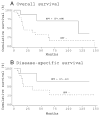Human papillomavirus-positive basaloid squamous cell carcinomas of the upper aerodigestive tract: a distinct clinicopathologic and molecular subtype of basaloid squamous cell carcinoma
- PMID: 20236687
- PMCID: PMC3873737
- DOI: 10.1016/j.humpath.2009.11.015
Human papillomavirus-positive basaloid squamous cell carcinomas of the upper aerodigestive tract: a distinct clinicopathologic and molecular subtype of basaloid squamous cell carcinoma
Abstract
Basaloid squamous cell carcinoma of the upper aerodigestive tract is a rare, morphologically distinct variant of squamous cell carcinoma that is thought to be clinically aggressive. The histologic features are distinct from, but often confused with, those of human papillomavirus-related oropharyngeal nonkeratinizing squamous cell carcinoma. The role of human papillomavirus as an etiologic agent in true basaloid squamous cell carcinoma is controversial. The purpose of this study was to determine human papillomavirus prevalence and its clinicopathologic significance in upper aerodigestive tract tumors with true basaloid squamous cell carcinoma histology. Twenty-eight cases were identified, 12 in the oropharynx and 16 in the larynx and/or hypopharynx. High-risk human papillomavirus in situ hybridization and immunohistochemistry for p16 and p53 were performed. Nine (75%) of the oropharyngeal and none of the larynx/hypopharynx tumors were human papillomavirus positive. Human papillomavirus-positive tumors affected younger patients. No significant statistical differences in patients' sex, tumor stage, treatment modality, or length of follow-up were observed between the 2 groups. Viral status showed a strong, positive correlation with p16 (P < .001) and a strong, negative correlation with p53 (P < .0001) immunoreactivity. Overall survival was better for human papillomavirus-positive basaloid squamous cell carcinomas (P < .05), with 86% of patients alive at 3 years compared with 35.3% of patients with human papillomavirus-negative tumors. These findings suggest that a subset of basaloid squamous cell carcinomas is virally driven. These tumors occur almost exclusively in the oropharynx, are molecularly distinct from their human papillomavirus-negative counterparts, and have a more favorable clinical outcome.
Copyright 2010 Elsevier Inc. All rights reserved.
Figures





Comment in
-
Human papillomavirus-positive basaloid squamous cell carcinomas of the head and neck.Hum Pathol. 2010 Oct;41(10):1505-6; author reply 1506. doi: 10.1016/j.humpath.2010.05.011. Hum Pathol. 2010. PMID: 20868902 No abstract available.
References
-
- Wain SL, Kier R, Vollmer RT, Bossen EH. Basaloid-squamous carcinoma of the tongue, hypopharynx, and larynx: report of 10 cases. Hum Pathol. 1986;17:1158–66. - PubMed
-
- Ide F, Shimoyama T, Horie N, Kusama K. Basaloid squamous cell carcinoma of the oral mucosa: a new case and review of 45 cases in the literature. Oral Oncol. 2002;38:120–4. - PubMed
-
- Paulino AF, Singh B, Shah JP, Huvos AG. Basaloid squamous cell carcinoma of the head and neck. Laryngoscope. 2000;110:1479–82. - PubMed
-
- Banks ER, Frierson HF, Jr, Mills SE, George E, Zarbo RJ, Swanson PE. Basaloid squamous cell carcinoma of the head and neck. A clinicopathologic and immunohistochemical study of 40 cases. Am J Surg Pathol. 1992;16:939–46. - PubMed
Publication types
MeSH terms
Grants and funding
LinkOut - more resources
Full Text Sources
Research Materials
Miscellaneous

